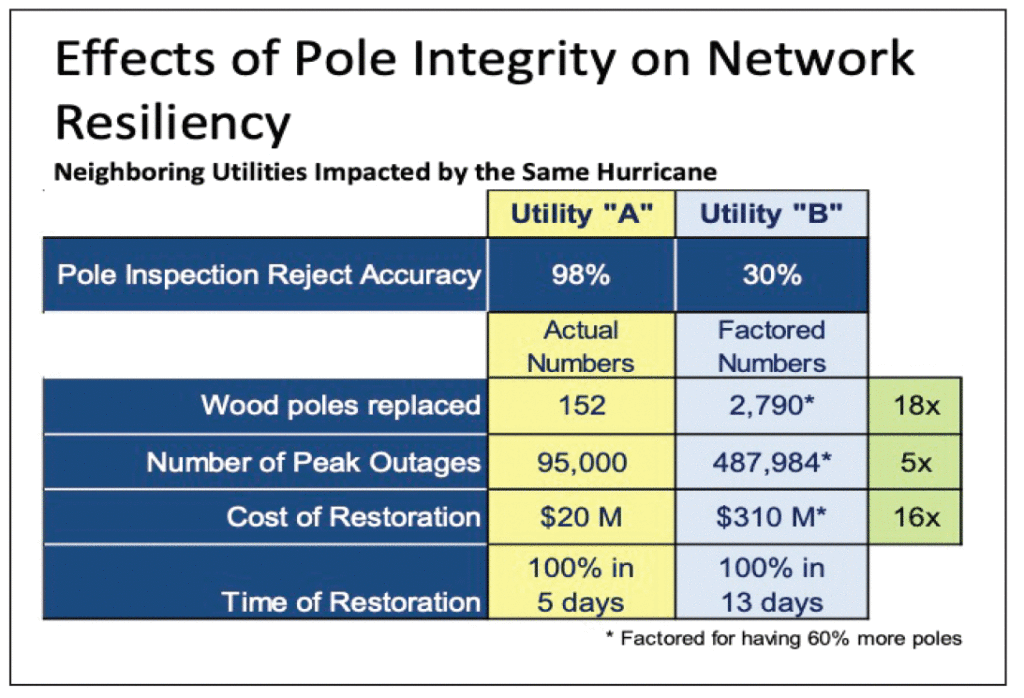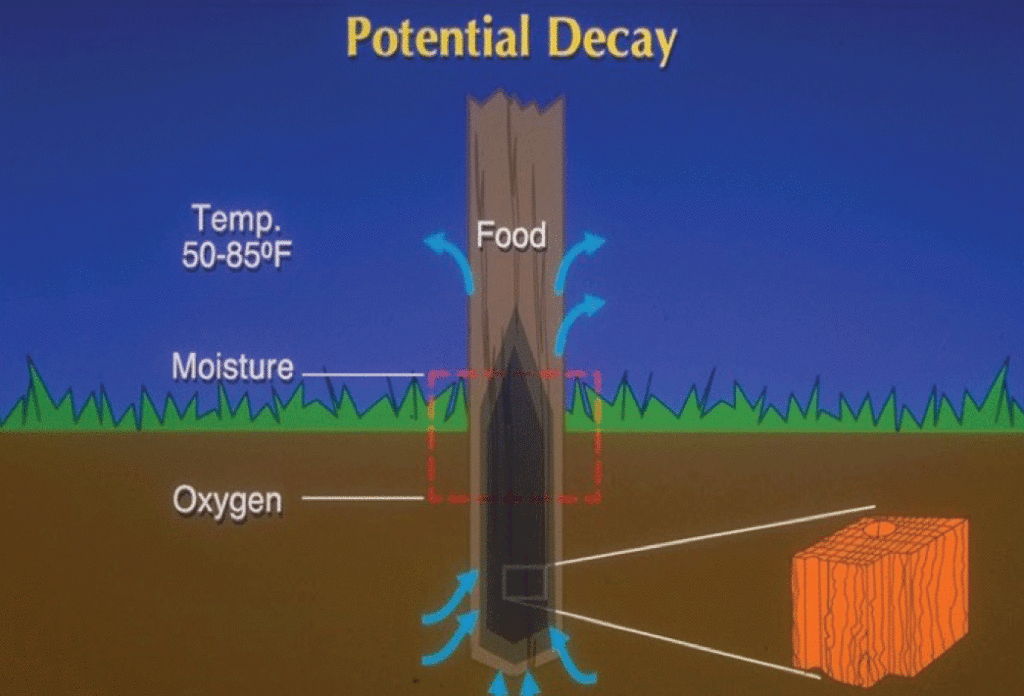The proper maintenance and inspection of the wood poles that support power and communications distribution systems illustrate how seemingly mundane matters often have far-reaching consequences.
The integrity of wood poles – that is, their retained strength and structural reliability – underlies power and communication system resiliency. If poles fall, power often goes out until the pole can be replaced. In a digital age, power outages and their duration have large negative impacts on people and the economy. Proper maintenance and inspection practices can mitigate these impacts and also save utilities money through lower total cost of ownership, extending pole lifetimes, and minimizing potential legal liability.
Structural integrity and, therefore, system resiliency are increasingly challenged by an increase in extreme weather events, as documented by the U.S. Energy Information Agency. The growth in mobile communications services entails more cellular equipment being installed on wood poles revised load calculations. It follows that if wood poles are damaged in an extreme weather event, the wireless telecom services crucial to storm recovery will also be degraded.
Structural Reliability
Initial structural criteria are set by the National Electrical Safety Code® (NESC®) with load factors in Section 25 and its Loading District map that establishes baseline standards for pole strength depending on the statistical impacts of ice and wind in various regions combined with strength factors in Section 26 for different pole applications.
Once installed, structural integrity depends on maintenance. The accompanying Figure 1 illustrates the vast difference in effectiveness between utility maintenance programs for wood poles, as reported by two adjacent utilities after a hurricane. The difference is stark for the number of poles replaced, number of peak outages, the cost of restoration, and time to restoration. The key difference between the two utilities is that one diligently pursued an inspection and groundline maintenance program.

As Figure 2 illustrates, over time, preservatives are depleted, providing food for insects and birds that prey on them. The plentiful supply of moisture and oxygen above and 18 inches below the groundline act as catalysts for decay. The same capillary action present in live trees occurs in the bottom of the pole leading to a wicking effect that spreads moisture and decay. As decay proceeds, it reduces pole strength, which over time, can lead to pole failure.

Comparing the capital cost of a wood pole to the cost of maintaining one is illuminating. Average pole life expectancy is around 45 years, but that varies based on location and related climatic factors. The replacement cost of a wood pole varies between urban or rural locations, but the average cost is $5,000, including the costs associated with transferring the supply and communications facilities. The average cost of maintenance for a wooden pole is $30-$40 per treatment, which might occur once per decade. Such a maintenance investment of $200 cost over four decades can avoid the cost of replacement providing an ROI of 2500%. Put simply, investment in operations and maintenance reduces investment in capital expenditures.
Whether utility leadership understands and embraces the metrics presented in Figure 1 is often a matter of organizational and accounting culture. Wood pole life is typically measured in decades. The benefits of methodical attention to detail over long spans of time are sometimes overlooked in the face of more immediate demands.
Inspection Considerations
Maintenance needs are directly related to effective inspections, which focus on elements such as pole age, pole history, visual assessment, and physical testing, as well as professional judgment.
A utility’s pole inspection program is typically tracked by its Geographic Information System (GIS). Each utility has its own guidelines for determining inspection priorities. For example, a two-year-old pole is unlikely to need an inspection. If a pole is more than 10-15 years old, it becomes a priority for inspection over time, which can vary by climatic zone.
The pole’s history may be apparent in the form of a metal inspection tag bearing the date of the prior inspection. A warning tag may document that the prior inspection identified the pole as unclimbable and a candidate for replacement.
Visual assessments may reveal a variety of issues. Is vegetation management needed? Is groundwater or soil erosion compromising the pole’s foundation? Do the pole’s guy wires need tightening? Is pole decay apparent? Is the load unbalanced – a transformer, telecom equipment – causing the pole to lean? As Figure 3 illustrates, partial or invasive excavation may be needed to assess the pole’s condition at the ground line.
Physical testing may be needed when professional judgment comes into play. Does a strike with a three-pound hammer elicit sounds reflecting decay? Can the pole be penetrated with a screwdriver? (It shouldn’t.) A core sample may be necessary to determine the type and extent of the decay.
If a utility or third-party annually inspects 10 percent of its eligible pole inventory, it will complete the inspection cycle once per decade. That average cycle may be longer in arid environs and shorter in moister climates to match the decay risk.

Conclusion
In the 21st century’s digital age, resiliency is the new mantra. The proper maintenance and inspection of a utility’s wood pole inventory has far-reaching consequences for system resiliency, as well as utility cost and liability. A culture of attention to detail should support a vigorous maintenance and inspection program.














Find Us on Socials